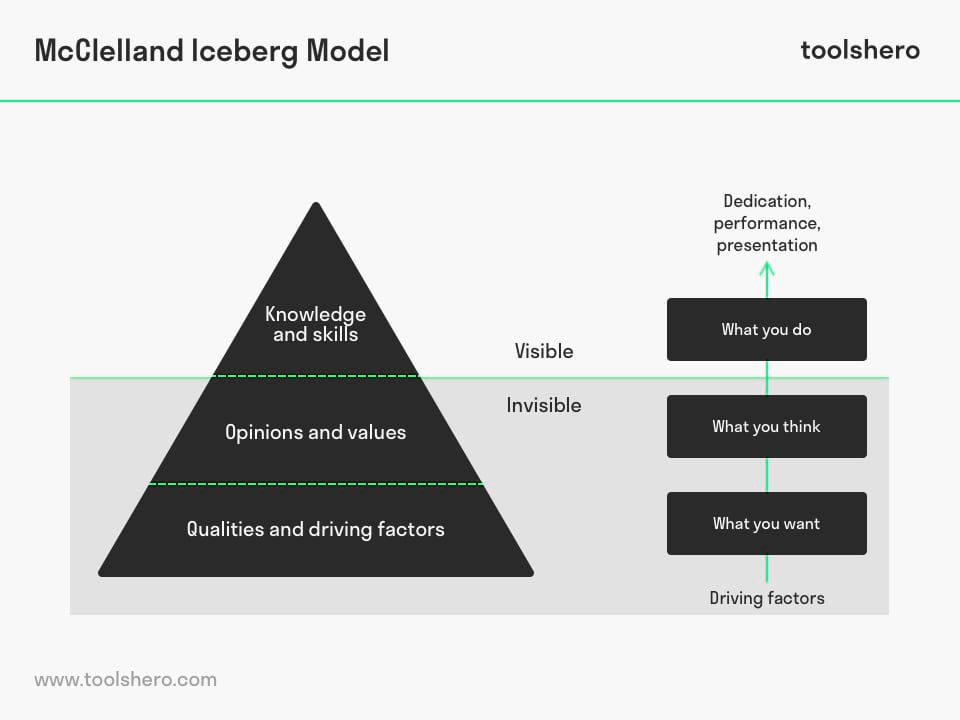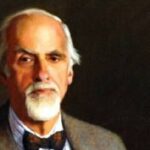McClelland Theory of Motivation

McClelland Theory of Motivation: this article explains the McClelland Theory of Motivation, developed by David McClelland, in a practical way. Next to what this theory is, this article also highlights the Iceberg model and linking this Theory of Motivation with the motivating drivers. After reading you will understand the basics of this motivation theory. Enjoy reading!
What is the McClelland Theory of Motivation?
The American psychologist David McClelland studied the way in which people satisfy their needs. What motivates people and what motivators are learned?
According to David McClelland, people have motivating drivers that are directly linked to need regardless of age, gender, culture or race.
As a result of the McClelland Theory of Motivation, David McClelland identified four types of motivational need:
- Need for achievement
- Need for power
- Need for affiliation
- Need for avoidance
Need for achievement
Generally speaking, people want to accomplish something in life. This could mean starting a large family for some and a well-paid job and an illustrious career for others. David McClelland studied what drives people to achieve something.
What motivates them and how can they make a contribution to society? Upon completing his study, he distinguished four characteristics that are consistent with the need for achievement: striving for an average task complexity, responsibility for own performance, the need for feedback and the use of innovation / creativity.
Need for power
People with a need for power, attach great value to status, reputation and recognition. They have a need to be perceived as important and they have a need to direct and influence others. According to David McClelland, this type of person enjoys competition and winning.
When this need is great, they will not be open to feedback. This need may consist of personal power and of institutional power. Those who focus on personal power have the desire to have control over others. Those who are focused on institutional power, like to organize the efforts of more people to further the company’s goals.
Need for affiliation
People are a gregarious bunch and they want to belong to the group. When the need for affiliation is high, they want to be liked and they will conform to the group’s behaviour and wishes. In this case, they will favour cooperation over competition. Therefore, the need for affiliation does not go well with the need for power.
Need for avoidance
This needs category was added later by David McClelland. When people do not wish to perform at the forefront and prefer to avoid unpleasant situations, this need will surface. People have fear of failure, fear of rejection and even fear of success. By avoiding situations that may trigger these fears, they think to have found a safe solution.
McClelland Theory of Motivation: the Iceberg model
David McClelland developed the iceberg model using the McClelland Theory of Motivation.

Figure 1 – McClelland Theory of Motivation: the Iceberg model
The Iceberg model of David McClelland looks at a person’s visible behaviour, knowledge and skills and the underlying unexpressed and unconscious deeper layers.
In general, a person’s knowledge, skills and behaviour can be found above the waterline of the iceberg. The central element is what they do. Below the waterline we find think and want, which focus on abstract terms such as standards, values and beliefs, self-esteem, characteristics, personality and motives.
These four invisible layers could reinforce one another as motives. However, they may also block the visible behaviour of the person in question,
Above the waterline
Anything above the waterline is powerful and tangible in which the focus is not on ‘what’ but on ‘how’.
In an organization this can be translated into an organizational vision and strategy, content, structure, finance and especially the result of work, working arrangements, training and giving feedback. This will create a guideline for employees.
Below the waterline
Below the waterline things are much more abstract and they are fed by the undercurrent. It is about the ever-present feeling without it being tangible. The relationships between people (interaction), their feelings, their expressiveness, sense of purpose can all be found below the waterline.
The organizational culture is also created below the waterline. The events below the waterline affect the events above the waterline. This is the reason why both levels must be taken into consideration in change processes.
McClelland Theory of Motivation and linking with the motivating drivers
David McClelland provides an insight into the (learned) needs of someone by his McClelland Motivation Theory and he links this to what this person does (above water level) and what they think and want (below the water level).
In an organization it is interesting to know what motivates employees in a team.
By looking at their behavior, they can be asked what they would ultimately like to achieve and what their real needs are.
It’s Your Turn
What do you think? Is the McClelland Theory of Motivation applicable in today’s management and development organizations? Do you recognize the practical explanation of the McClelland Theory of Motivation of do you have more suggestions? What are your success factors which you would like to share?
Share your experience and knowledge in the comments box below.
More information about the McClelland Theory of Motivation
- Burnham, D. H. (2008). Power Is the Great Motivator. Harvard Business Review Press.
- McClelland, D. C., Koestner, R., & Weinberger, J. (1989). How do self-attributed and implicit motives differ?. Psychological review, 96(4), 690.
- McClelland, D. C. (1987). Human motivation. CUP Archive.
- McClelland, D. C. (1985). How motives, skills, and values determine what people do. American Psychologist, 40(7), 812.
How to cite this article:
Mulder, P. (2015). McClelland Theory of Motivation. Retrieved [insert date] from Toolshero: https://www.toolshero.com/psychology/mcclelland-theory-of-motivation/
Original publication date: 03/09/2015 | Last update: 03/19/2024
Add a link to this page on your website:
<a href=”https://www.toolshero.com/psychology/mcclelland-theory-of-motivation/”>Toolshero: McClelland Theory of Motivation</a>













4 responses to “McClelland Theory of Motivation”
Regarding need for avoidance, unlike a dozen other articles your article is only one mentioning this. Is it that it is insignificant?
Thank you for your comment, Sai. Regarding your question, if you read further in the article, it’s mentioned that the need for avoidance is later added by David McClelland, based on further research and theory development. Hopefully this answers your question.
Thanks a lot sir for your valuable topic on achievement motivation. But I wanted to that how this theory can apply in field of education or in learning process of education from children to Adulthood.
Thank you for your comment, Philomina.